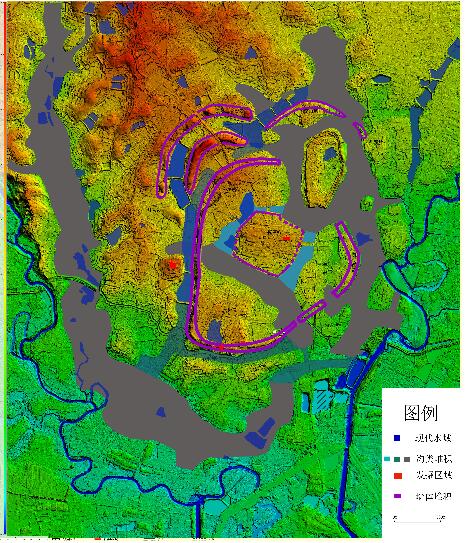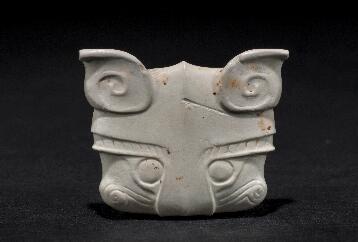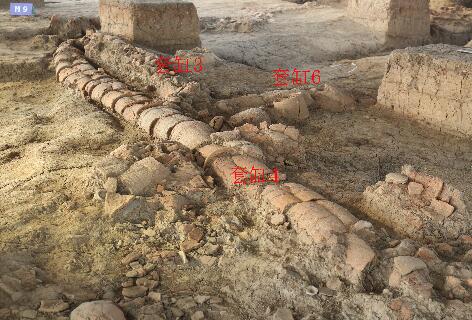New Discoeries at Shijiahe - a Central Prehistoric Settlement in the Middle Yangzi Region
From:Shanghai Archaeology Forum NetWriter:Date:2017-12-12
The Shijiahe site is located in the town of Shihe in Tianmen City, Hubei Province. It is situated at the southern foothills of the Dahong Mountain and the piedmont area of the Northern Jianghan Plains. Shijiahe, measuring an area of eight square kilometers, is the largest, most well-preserved, and, chronologically, the longest-spanning prehistoric settlement excavated to date in the Middle Yangtze River Valley.Shijiahe was discovered in 1954. Between 1955 and 1992, multiple archaeological surveys and excavations were conducted at the site, which established the archaeological cultural sequence and Shijiahe’s position as the core of a settlement cluster, laying the foundation for the study of the Shijiahe site. The large-scale architecture, bronzes, jades, inscribed symbols, and ritual features uncovered have provided an abundance of information on prehistoric civilization, crucial for exploring the development of Chinese civilization. Shijiahe experienced four archaeological cultural phases including the Youziling culture (5900BP to 5100BP), the Qujialing culture (5100BP to 4500 BP), the Shijiahe culture (4500BP to 4200BP), and the Post-Shijiahe culture (4200BP to 4000BP). Among these archaeological cultures, the cultural development from the Youziling culture period to the Shijiahe culture period was very similar, indicating that the Youziling, Qujialing, and Shijiahe cultures were all closely related to one another. However, after the Shijiahe culture period, the material culture at the site experienced a relatively substantial change. This signifies that by this period, the site experienced a shift or a rupture in the archeological cultural genealogy.

In 2008, in order to understand the layout and structure of Shijiahe and to examine the role and function of the site in the development of Chinese Civilization, the Hubei Provincial Institute of Cultural Relics and Archaeology conducted a systematic archaeological survey of a 150 square kilometer area centered on the Shijiahe site. 73 prehistoric sites were discovered in this survey. In 2011, excavations confirmed the remains of a city wall in the gap at the southeastern portion of Shijiahe city site. Between 2014 and 2016, The Hubei Provincial Institute of Cultural Relics and Archaeology, Peking University’s School of Archaeology and Museology, and the Tianmen Museum collaborated on a coring and excavation project at the core area of Shijiahe. Sites such as Tanjialling, Yinxintai, Sanfangwan, and Yanjiashan were excavated. The total coring area measured approximately three square kilometers and the total excavation area measured approximately 3375 square meters. This project yielded several significant results.
First, based on the coring results, the remains of multiple large, man-made city moats are present in the main area of Shijiahe, providing a macroscopic understanding of the layout and structure of the site. The newly discovered Tanjialing city site is situated in the center of Shijiahe and is roughly the shape of a rounded square. The city wall measures 440 meters in the east-west direction and 390 meters in the north-south direction. The area encircled by the city walls measures 170,000 square meters, while the area encircled by the city moat measures 260,000 square meters.
Second, the discovery and excavation of archaeological sites such as Tanjialing, Sanfangwan, Yinxintai, and Yanjiashan have provided new data for the study of the evolution of Shijiahe’s settlement structure and settlement functions at Shijiahe city site.

The city wall, located in the northern portion of the Tanjialing city site, was constructed with relatively pure loess during the Late Youziling culture period. The top portion is 14.5 meters wide and 3.1 meters thick. The city moat measures 30 meters in width and nine meters in depth. A row of upright wooden remains was erected in a layer of silt. Tanjialing is the largest prehistoric city dated to the period of the Youziling culture.
In the upland area of the eastern portion of Tanjialing, multiple weng-urn coffin tombs and associated mortuary jade objects dated to the Post-Shijiahe culture period were uncovered. An architectural foundation with an area of 144 square meters was dated to the Late Shijiahe culture period, and a few earthen pit tombs dated to the Early Qujialing culture were also excavated. All these findings provide an initial understanding of settlement pattern changes in this region.
At Sanfangwan site, pottery kilns, loess deposits, loess pits, clay-soaking pits, water tanks, and tens of thousands of potsherds from red ceramic cups were discovered. These archaeological remains suggest the presence of a specialized pottery kiln workshop for the production of red ceramic cups during the Late Shijiahe to Post-Shijiahe culture periods.
At Yinxintai, five man-made mounded platforms were discovered. Numerous features and artifacts such as more than 100 weng-urn coffin tombs and kou-bowls were found along the base of the platform. Between the platform foundation and the ground was a large amount of Late Shijiahe culture fragments from thick, red ceramic cylinders and red ceramic cups, along with a small amount of human remains. Some of the red ceramic cup remains were buried in an orderly fashion, stacked one inside another. Multiple symbols were carved onto some of the red ceramic vats. Based on these excavated remains, it can be speculated that this could have been a specialized area for ritual activities during the Late Shijiahe culture period; it is also the largest prehistoric ritual venue found to date in the Middle Yangtze River Valley.

The wall deposits at Yanjiashan were overlaid by Late Shijiahe culture deposits. The wall is dated to no later than the Late Shijiahe culture period. The stones that make up the mounds at the site are brittle, grayish-white dolomite. Some of the dolomite fragments exhibit traces of hammering, grinding, and drilling. Other artifacts excavated next to the stone mounds consist of small stone knives and arrowheads. It is speculated that this area of the site was a small-scale stone tool production locale from the Late Shijiahe culture period to the Post-Shijiahe culture period. The 30 pieces of jade fragments buried along with the 20 weng-urn coffin tombs have provided new evidence for the social status of the tomb occupants from the Post-Shijiahe culture period.
Third, a batch of jade remains dated to the Post-Shijiahe culture period was discovered, enriching our understanding of the development of the Chinese Civilization. The discovery of 240 pieces of exquisite jade artifacts from the five weng-urn coffin tombs at Tanjialing is another example of a discovery of concentrated jade artifacts dated to the Post-Shijiahe culture period at the Shijiahe site. These newly excavated jade artifacts contain an array of unprecedented forms such as deity portraits, double-headed and conjoined half-circle jade rings, tiger-based double eagle jade pendants, jade tigers, and jade eagles. There is an abundant variety of forms, which are elegant and vivid, displaying exquisite production techniques. The sculpting skills of the jade remains reflect the highest level of jade craftsmanship in prehistoric China and East Asia.
The aforementioned archaeological research provides insight into the settlement transformations at Shijiahe, the formation of a regional civilization center, and the development of a pluralistic, integrated Chinese Civilization.
The multi-layered, large-scale man-made city gate and city moat feature at the core of Shijiahe were not constructed rapidly over a short period of time. Rather, the construction and reconstruction of the feature occurred over a long period time. The transformation of the encircled settlement can be divided into three phases. The Tanjialing city site is dated to the earliest period and is located in the upland area of the center of Shijiahe. It spans the Late Youziling culture period until the Early Qujialing culture period. During this period, the Longzui city site, constructed during the Early Youziling culture period, was abandoned and Tanjialing, located six kilometers north of Longzui, became the new cultural center. Between the Late Qujialing culture period and the Shijiahe culture period, the settlement structure of Shijiahe experienced a substantial number of changes. At this time, the magnificent Shijiahe city site, measuring 1,200,000 square meters, was constructed and the Tanjialing city site, situated in the center of Shijiahe was abandoned and transformed into a major residential center. The settlement cluster, centered on Shijiahe, was hereafter formed. During the Late Shijiahe culture period, the formation of two man-made mounded loess walls in the western and northern portions outside of the Shijiahe city site could have been related to Shijiahe expansionist construction projects. During the Post-Shijiahe culture period, the Shijiahe settlement again experienced substantial transformations. The original city moat collapsed, settlements became more sparsely distributed, and there was no obvious settlement center.
The civilization process in the Middle Yangtze River Valley began approximately during the Youziling culture period. At this time, a suite of features associated with complex society appeared, including the construction of the Tanjialing city site, the largest settlement dated to this period. Between the Qujialing culture period and the Shijiahe culture period, the degree of social complexity intensified in the Middle Yangtze River Valley, thus providing an example of a pluralistic pattern in early Chinese Civilization. Based on the rich cultural deposits at Shijiahe, during this period in the Middle Yangtze River Valley, more than ten cities of varying scales appeared creating a lattice structure, substantial settlement and internal social hierarchies were formed, and the social division of labor became increasingly refined. These features demonstrate Shijiahe’s rich cultural heritage. Whether from the Middle Yangtze River Valley’s largest Shijiahe city site, the large-scale residential site of Tanjialing, the large ritual architecture at Yinxintai, the pottery production workshop at Sanfangwan, other areas with specialized settlement functions, or the excavated carved symbols and exquisite artifacts from materials such as malachite, we can conclude that Shijiahe was undoubtedly the center of civilization in the Middle Yangtze River Valley, possessing the power to absorb and radiate cultural influences in the region.
Pluralistic integration is a crucial characteristic of the development of the Chinese Civilization. The regional civilization formed during the Post-Shijiahe culture period in the Middle Yangtze River Valley centered on Shijiahe did not continue on the same trajectory. The development of non-local cultural traditions such as burying jade objects in weng-urn coffin tombs, the use of pottery originating from the Wangwan Phase III Culture of the Central Plains, and traces of Donglong culture from Shandong Province cultures in the Middle Yangtze River was interrupted. The Shijiahe culture represented by the site of Shijiahe thereafter was integrated into the Yellow River civilization cultural system. The Shijiahe city site disintegrated and a regional settlement cluster center has yet to be discovered for this period. However, the discovery of cultural remains such as exquisite jade artifacts, jade production features, ceramic art pieces, and bronzes, indicates that thriving craft production sectors were still present and the associated culture continued to flourish, with clear social hierarchy further differentiated. Shijiahe during the Post-Shijiahe culture period provides an early example of the pluralistic integration of Chinese Civilization.

